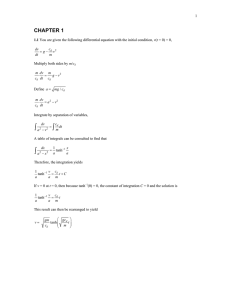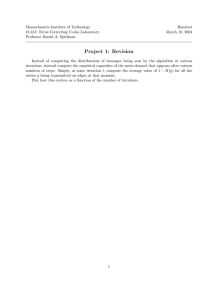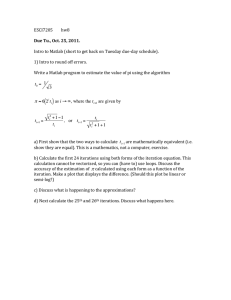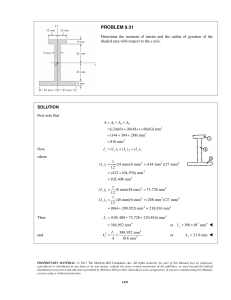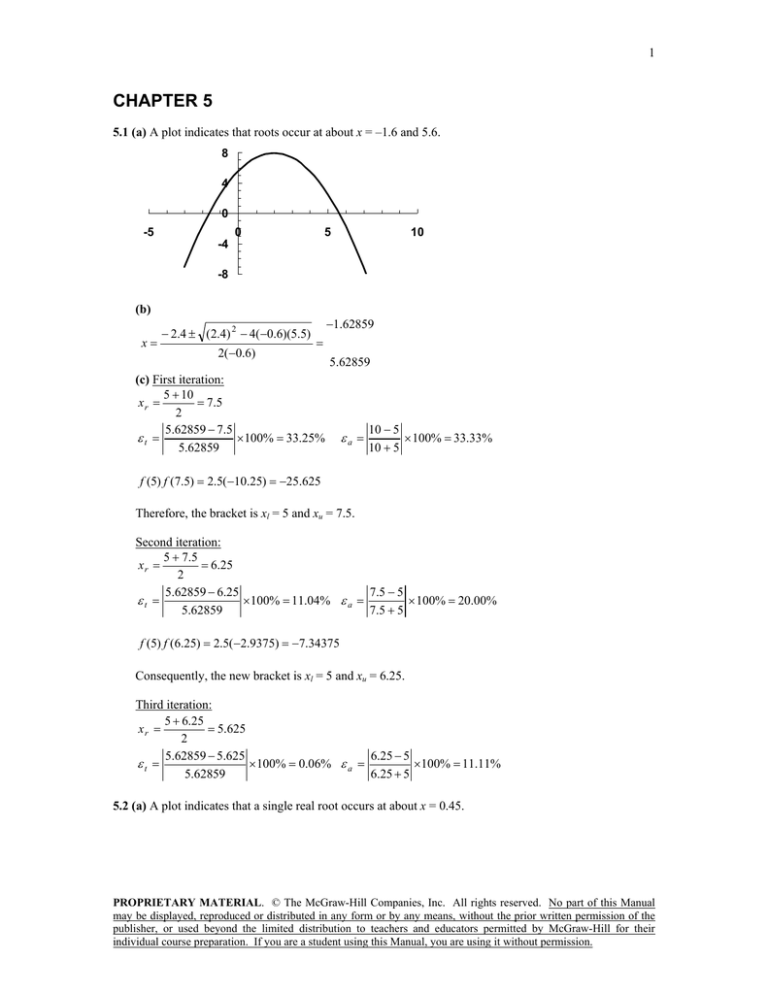
1
CHAPTER 5
5.1 (a) A plot indicates that roots occur at about x = –1.6 and 5.6.
8
4
0
-5
0
5
10
-4
-8
(b)
x=
− 2.4 ± (2.4) 2 − 4(−0.6)(5.5)
2(−0.6)
−1.62859
=
5.62859
(c) First iteration:
5 + 10
xr =
= 7.5
2
5.62859 − 7.5
εt =
× 100% = 33.25%
5.62859
εa =
10 − 5
× 100% = 33.33%
10 + 5
f (5) f (7.5) = 2.5(−10.25) = −25.625
Therefore, the bracket is xl = 5 and xu = 7.5.
Second iteration:
5 + 7.5
xr =
= 6.25
2
5.62859 − 6.25
7.5 − 5
εt =
× 100% = 11.04% ε a =
× 100% = 20.00%
7.5 + 5
5.62859
f (5) f (6.25) = 2.5(−2.9375) = −7.34375
Consequently, the new bracket is xl = 5 and xu = 6.25.
Third iteration:
5 + 6.25
xr =
= 5.625
2
5.62859 − 5.625
6.25 − 5
εt =
× 100% = 0.06% ε a =
× 100% = 11.11%
5.62859
6.25 + 5
5.2 (a) A plot indicates that a single real root occurs at about x = 0.45.
PROPRIETARY MATERIAL. © The McGraw-Hill Companies, Inc. All rights reserved. No part of this Manual
may be displayed, reproduced or distributed in any form or by any means, without the prior written permission of the
publisher, or used beyond the limited distribution to teachers and educators permitted by McGraw-Hill for their
individual course preparation. If you are a student using this Manual, you are using it without permission.
3
Therefore, the new bracket is xl = 0.5 and xu = 0.75. The process can be repeated until the approximate
error falls below 10%. As summarized below, this occurs after 4 iterations yielding a root estimate of
0.53125.
iteration
1
2
3
4
xl
0.50000
0.50000
0.50000
0.50000
xu
1.00000
0.75000
0.62500
0.56250
xr
0.75000
0.62500
0.56250
0.53125
f(xl)
-1.21875
-1.21875
-1.21875
-1.21875
f(xr)
2.83105
1.19498
0.10600
-0.52422
f(xl)×f(xr)
-3.45035
-1.45638
-0.12918
0.63889
εa
33.33%
20.00%
11.11%
5.88%
(c) False position:
First iteration:
xl = 0.5
f(xl) = –1.21875
xu = 1
f(xu) = 5
5(0.5 − 1)
= 0.59799
xr = 1 −
− 1.21875 − 5
f (0.5) f (0.59799) = −1.2175(0.75057) = −0.91475
Therefore, the bracket is xl = 0.5 and xu = 0.59799.
Second iteration:
xl = 0.5
f(xl) = –1.21875
xu = 0.59799
f(xu) = 0.75057
0.75057(0.5 − 0.59799)
x r = 0.59799 −
= 0.56064
− 1.21875 − 0.75057
0.56064 − 0.59799
× 100% = 6.661%
εa =
0.56064
The process can be repeated until the approximate error falls below 0.2%. As summarized below, this
occurs after 4 iterations yielding a root estimate of 0.55705.
iteration
1
2
3
4
xl
0.5
0.5
0.5
0.5
xu
1.00000
0.59799
0.56064
0.55734
f(xl)
-1.21875
-1.21875
-1.21875
-1.21875
f(xu)
5.00000
0.75057
0.07024
0.00610
xr
0.59799
0.56064
0.55734
0.55705
f(xr)
0.75057
0.07024
0.00610
0.00053
f(xl)×f(xr)
-0.91475
-0.08561
-0.00744
-0.00064
εa
6.661%
0.593%
0.051%
5.4 (a) The graph indicates that roots are located at about –0.5, 2 and 4.7.
40
20
0
-2
0
2
4
6
-20
(b) Using bisection, the first iteration is
PROPRIETARY MATERIAL. © The McGraw-Hill Companies, Inc. All rights reserved. No part of this Manual
may be displayed, reproduced or distributed in any form or by any means, without the prior written permission of the
publisher, or used beyond the limited distribution to teachers and educators permitted by McGraw-Hill for their
individual course preparation. If you are a student using this Manual, you are using it without permission.
4
−1 + 0
= −0.5
2
f (−1) f (−0.5) = 29(2.125) = 61.625
xr =
Therefore, the root is in the second interval and the lower guess is redefined as xl = –0.5. The second
iteration is
−0.5 + 0
= −0.25
2
− 0.25 − (−0.5)
εa =
100% = 100%
− 0.25
xr =
f (−0.5) f (−0.25) = 2.125(−6.76563) = −14.37695
Consequently, the root is in the first interval and the upper guess is redefined as xu = –0.25. All the
iterations are displayed in the following table:
i
1
2
3
4
5
6
7
8
xl
-1.0
-0.5
-0.5
-0.5
-0.50000
-0.46875
-0.45313
-0.45313
f(xl)
29.00000
2.12500
2.12500
2.12500
2.12500
0.85880
0.24273
0.24273
xu
0
0
-0.25
-0.375
-0.438
-0.43750
-0.43750
-0.44531
f(xu)
-13.00000
-13.00000
-6.76563
-2.66992
-0.36206
-0.36206
-0.36206
-0.06107
xr
-0.5
-0.25
-0.375
-0.43750
-0.46875
-0.45313
-0.44531
-0.44922
f(xr)
2.12500
-6.76563
-2.66992
-0.36206
0.85880
0.24273
-0.06107
0.09048
εa
100.00%
100.00%
33.33%
14.29%
6.67%
3.45%
1.75%
0.87%
Thus, after eight iterations, we obtain a root estimate of −0.44922 with an approximate error of 0.87%,
which is below the stopping criterion of 1%.
(c) Using false position, the first iteration is
xr = 0 −
−13(−1 − 0)
= −0.30952
29 − (−13)
f (−1) f (−0.30952) = 29(−4.90027) = −142.10775
Therefore, the root is in the first interval and the upper guess is redefined as xu = –0.30952. The second
iteration is
x r = −0.30952 −
εa =
−4.90027(−1 − (−0.30952))
= −0.40933
29 − (−4.90027)
− 0.40933 − (−0.30952)
100% = 24.383%
− 0.40933
f (−1) f (−0.40933) = 29(−1.42411) = −41.29925
Consequently, the root is in the first interval and the upper guess is redefined as xu = –0.40933. All the
iterations are displayed in the following table:
i
1
2
xl
-1
-1
f(xl)
29.00
29.00
xu
0
-0.30952
f(xu)
-13
-4.90027
xr
-0.30952
-0.40933
f(xr)
-4.90027
-1.42411
εa
24.383%
PROPRIETARY MATERIAL. © The McGraw-Hill Companies, Inc. All rights reserved. No part of this Manual
may be displayed, reproduced or distributed in any form or by any means, without the prior written permission of the
publisher, or used beyond the limited distribution to teachers and educators permitted by McGraw-Hill for their
individual course preparation. If you are a student using this Manual, you are using it without permission.
5
3
4
5
-1
-1
-1
29.00
29.00
29.00
-0.40933
-0.43698
-0.44430
-1.42411
-0.38199
-0.10024
-0.43698
-0.44430
-0.44621
-0.38199
-0.10024
-0.02615
6.327%
1.647%
0.429%
Therefore, after five iterations we obtain a root estimate of –0.44621 with an approximate error of
0.429%, which is below the stopping criterion of 1%.
5.5 A graph indicates that a nontrivial root (i.e., nonzero) is located at about 0.93.
0.5
0
-0.5
0
0.5
1
1.5
-1
-1.5
Using bisection, the first iteration is
0.5 + 1
= 0.75
2
f (0.5) f (0.75) = 0.354426(0.2597638) = 0.092067
xr =
Therefore, the root is in the second interval and the lower guess is redefined as xl = 0.75. The second
iteration is
0.75 + 1
= 0.875
2
0.875 − 0.75
εa =
100% = 14.29%
0.875
xr =
f (0.75) f (0.875) = 0.259764(0.0976216) = 0.025359
Because the product is positive, the root is in the second interval and the lower guess is redefined as xl
= 0.875. All the iterations are displayed in the following table:
i
1
2
3
4
5
xl
0.5
0.75
0.875
0.875
0.90625
f(xl)
0.354426
0.259764
0.097622
0.097622
0.042903
xu
1
1
1
0.9375
0.9375
f(xu)
-0.158529
-0.158529
-0.158529
-0.0178935
-0.0178935
xr
0.75
0.875
0.9375
0.90625
0.921875
f(xr)
0.2597638
0.0976216
-0.0178935
0.0429034
0.0132774
εa
14.29%
6.67%
3.45%
1.69%
Consequently, after five iterations we obtain a root estimate of 0.921875 with an approximate error of
1.69%, which is below the stopping criterion of 2%. The result can be checked by substituting it into
the original equation to verify that it is close to zero.
f ( x) = sin( x) − x 3 = sin(0.921875) − 0.921875 3 = 0.0132774
5.6 (a) A graph of the function indicates a positive real root at approximately x = 1.2.
PROPRIETARY MATERIAL. © The McGraw-Hill Companies, Inc. All rights reserved. No part of this Manual
may be displayed, reproduced or distributed in any form or by any means, without the prior written permission of the
publisher, or used beyond the limited distribution to teachers and educators permitted by McGraw-Hill for their
individual course preparation. If you are a student using this Manual, you are using it without permission.
8
1
2
3
1
1
1
3.00000
2.87500
2.79688
0.5
0.5
0.5
-0.03333
-0.02174
-0.01397
2.87500
2.79688
2.74805
-0.02174
-0.01397
-0.00888
-0.01087
-0.00698
-0.00444
2.793%
1.777%
7.81%
4.88%
3.05%
Therefore, after three iterations we obtain a root estimate of 2.74805 with an approximate error of
1.777%. Note that the true error is greater than the approximate error. This is not good because it
means that we could stop the computation based on the erroneous assumption that the true error is at
least as good as the approximate error. This is due to the slow convergence that results from the
function’s shape.
5.8 The square root of 18 can be set up as a roots problem by determining the positive root of the function
f ( x) = x 2 − 18 = 0
Using false position, the first iteration is
7(4 − 5)
= 4.22222
−2−7
f (4) f (4.22222) = −2(−0.17284) = 0.34568
xr = 5 −
Therefore, the root is in the second interval and the lower guess is redefined as xl = 4.22222. The
second iteration is
7(4.22222 − 5)
= 4.24096
− 0.17284 − 7
4.24096 − 4.22222
εa =
100% = 0.442%
4.24096
x r = 4.22222 −
Thus, the computation can be stopped after just two iterations because 0.442% < 0.5%. Note that the
true value is 4.2426. The technique converges so quickly because the function is very close to being a
straight line in the interval between the guesses as in the plot of the function shown below.
10
5
0
-5
4
4.5
5
5.9 A graph of the function indicates a positive real root at approximately x = 3.7.
10
0
0
1
2
3
4
5
-10
Using false position, the first iteration is
PROPRIETARY MATERIAL. © The McGraw-Hill Companies, Inc. All rights reserved. No part of this Manual
may be displayed, reproduced or distributed in any form or by any means, without the prior written permission of the
publisher, or used beyond the limited distribution to teachers and educators permitted by McGraw-Hill for their
individual course preparation. If you are a student using this Manual, you are using it without permission.
9
10.43182(0 − 5)
= 1.62003
− 5 − 10.43182
f (0) f (1.62003) = −5(−4.22944) = 21.147
xr = 5 −
Therefore, the root is in the second interval and the lower guess is redefined as xl = 1.62003. The
remaining iterations are summarized below
i
1
2
3
4
5
6
xl
0
1.62003
2.59507
3.34532
3.62722
3.71242
xu
5.00000
5.00000
5.00000
5.00000
5.00000
5.00000
f(xl)
-5
-4.2294
-4.7298
-2.1422
-0.6903
-0.197
f(xu)
10.43182
10.43182
10.43182
10.43182
10.43182
10.43182
xr
1.62003
2.59507
3.34532
3.62722
3.71242
3.73628
f(xr)
-4.22944
-4.72984
-2.14219
-0.69027
-0.19700
-0.05424
f(xl)×f(xr)
21.14722
20.00459
10.13219
1.47869
0.13598
0.01069
εa
37.573%
22.427%
7.772%
2.295%
0.639%
The final result, xr = 3.73628, can be checked by substituting it into the original function to yield a
near-zero result,
f (3.73628) = (3.73628) 2 cos 3.73628 − 5 = −0.05424
5.10 Using false position, the first iteration is
7(4.5 − 6)
= 5.01754
− 3.6875 − 7
f (4.5) f (5.01754) = −3.6875(−1.00147) = 3.69294
xr = 6 −
Therefore, the root is in the second interval and the lower guess is redefined as xu = 5.01754. The true
error can be computed as
εt =
5.60979 − 5.01754
100% = 10.56%
5.60979
The second iteration is
7(5.01754 − 6)
= 5.14051
− 1.00147 − 7
5.60979 − 5.14051
εt =
100% = 8.37%
5.60979
xr = 6 −
εa =
5.14051 − 5.01754
100% = 2.392%
5.14051
f (5.01754) f (5.14051) = −1.00147(−1.06504) = 1.06661
Consequently, the root is in the second interval and the lower guess is redefined as xu = 5.14051. All
the iterations are displayed in the following table:
i
1
2
3
xl
4.50000
5.01754
5.14051
xu
6
6
6
f(xl)
-3.68750
-1.00147
-1.06504
f(xu)
7.00000
7.00000
7.00000
xr
5.01754
5.14051
5.25401
f(xr)
-1.00147
-1.06504
-1.12177
f(xl)×f(xr)
3.69294
1.06661
1.19473
εa, %
εt, %
2.392
2.160
10.56
8.37
6.34
PROPRIETARY MATERIAL. © The McGraw-Hill Companies, Inc. All rights reserved. No part of this Manual
may be displayed, reproduced or distributed in any form or by any means, without the prior written permission of the
publisher, or used beyond the limited distribution to teachers and educators permitted by McGraw-Hill for their
individual course preparation. If you are a student using this Manual, you are using it without permission.
10
4
5
6
7
5.25401
5.35705
5.44264
5.50617
6
6
6
6
-1.12177
-1.07496
-0.90055
-0.65919
7.00000
7.00000
7.00000
7.00000
5.35705
5.44264
5.50617
5.54867
-1.07496
-0.90055
-0.65919
-0.43252
1.20586
0.96805
0.59363
0.28511
1.923
1.573
1.154
0.766
4.51
2.98
1.85
1.09
Notice that the results have the undesirable feature that the true error is greater than the approximate
error. This is not good because it means that we could stop the computation based on the erroneous
assumption that the true error is at least as good as the approximate error. This is due to the slow
convergence that results from the function’s shape as shown in the following plot (recall Fig. 5.14).
8
6
4
2
0
-2 4
4.5
5
5.5
6
-4
-6
5.11 (a)
x r = (80)1 / 3.5 = 3.497357
(b) Here is a summary of the results obtained with false position to the point that the approximate error
falls below the stopping criterion of 2.5%:
i
1
2
3
4
xl
2
2.768318
3.176817
3.364213
xu
5
5
5
5
f(xl)
-68.68629
-44.70153
-22.85572
-10.16193
f(xu)
199.5085
199.5085
199.5085
199.5085
xr
2.76832
3.17682
3.36421
3.44349
f(xr)
-44.70153
-22.85572
-10.16193
-4.229976
f(xl)×f(xr)
3070.382
1021.686
232.258
42.985
εa
12.859%
5.570%
2.302%
5.12 A plot of the function indicates a maximum at about 0.9.
10
5
0
-0.5
-5
0
0.5
1
1.5
-10
In order to determine the maximum with a root location technique, we must first differentiate the
function to yield
f ' ( x) = −12 x 5 − 6.4 x 3 + 12
PROPRIETARY MATERIAL. © The McGraw-Hill Companies, Inc. All rights reserved. No part of this Manual
may be displayed, reproduced or distributed in any form or by any means, without the prior written permission of the
publisher, or used beyond the limited distribution to teachers and educators permitted by McGraw-Hill for their
individual course preparation. If you are a student using this Manual, you are using it without permission.
3
6.3 (a) Fixed point. The equation can be solved in two ways. The way that converges is
x i +1 = 1.8 x i + 2.5
The resulting iterations are
i
εa
xi
5
3.391165
2.933274
2.789246
2.742379
2.726955
2.721859
2.720174
2.719616
0
1
2
3
4
5
6
7
8
47.44%
15.61%
5.16%
1.71%
0.57%
0.19%
0.06%
0.02%
(b) Newton-Raphson
x i +1 = x i −
i
− x i2 + 1.8 x i + 2.5
− 2 x i + 1.8
xi
0
1
2
3
4
5
f (x )
5
3.353659
2.801332
2.721108
2.719341
2.719341
-13.5
-2.71044
-0.30506
-0.00644
-3.1E-06
-7.4E-13
f'(x)
εa
-8.2
-4.90732
-3.80266
-3.64222
-3.63868
-3.63868
49.09%
19.72%
2.95%
0.06%
0.00%
6.4 (a) A graph of the function indicates that there are 3 real roots at approximately 0.2, 1.5 and 6.3.
20
10
0
-10
0
2
4
6
-20
(b) The Newton-Raphson method can be set up as
x i +1 = x i −
− 1 + 5.5 x i − 4 x i2 + 0.5 x i3
5.5 − 8 x i + 1.5 x i2
This formula can be solved iteratively to determine the three roots as summarized in the following
tables:
PROPRIETARY MATERIAL. © The McGraw-Hill Companies, Inc. All rights reserved. No part of this Manual
may be displayed, reproduced or distributed in any form or by any means, without the prior written permission of the
publisher, or used beyond the limited distribution to teachers and educators permitted by McGraw-Hill for their
individual course preparation. If you are a student using this Manual, you are using it without permission.
4
i
0
1
2
3
4
i
0
1
2
3
4
i
0
1
2
3
4
xi
0
0.181818
0.213375
0.214332
0.214333
xi
2
1.555556
1.482723
1.479775
1.479769
xi
6
6.347826
6.306535
6.305898
6.305898
f (x )
-1
-0.12923
-0.0037
-3.4E-06
-2.8E-12
f'(x)
εa
5.5
4.095041 100.000000%
3.861294 14.789338%
3.85425
0.446594%
3.854244
0.000408%
εa
f (x )
f'(x)
-2
-0.24143
-0.00903
-1.5E-05
-4.6E-11
-4.5
-3.31481 28.571429%
-3.06408 4.912085%
-3.0536 0.199247%
-3.05358 0.000342%
f (x )
f'(x)
-4
0.625955
0.009379
2.22E-06
1.42E-13
11.5
15.15974
14.7063
14.69934
14.69934
εa
5.479452%
0.654728%
0.010114%
0.000002%
Therefore, the roots are 0.214333, 1.479769, and 6.305898.
6.5 (a) The Newton-Raphson method can be set up as
x i +1 = x i −
− 2 + 6 x i − 4 x i2 + 0.5 x i3
6 − 8 x i + 1.5 x i2
Using an initial guess of 4.2, this formula jumps around and eventually converges on the root at
0.474572 after 9 iterations:
i
0
1
2
3
4
5
6
7
8
9
xi
4.2
-4.84912
-2.57392
-1.13753
-0.27274
0.20283
0.415354
0.470574
0.474552
0.474572
f (x )
f'(x)
εa
-10.316
-182.162
-52.4699
-14.737
-3.94412
-0.94341
-0.16212
-0.01021
-5.2E-05
-1.4E-09
-1.14
80.06397
36.52895
17.04115
8.293487
4.439071
2.935948
2.567567
2.541384
2.541249
186.61%
88.39%
126.27%
317.08%
234.47%
51.17%
11.73%
0.84%
0.00%
The reason for the behavior is depicted in the following plot. As can be seen, the guess of x = 4.2
corresponds to a small negative slope of the function. Hence, the first iteration shoots to a negative
value that is far from a root.
PROPRIETARY MATERIAL. © The McGraw-Hill Companies, Inc. All rights reserved. No part of this Manual
may be displayed, reproduced or distributed in any form or by any means, without the prior written permission of the
publisher, or used beyond the limited distribution to teachers and educators permitted by McGraw-Hill for their
individual course preparation. If you are a student using this Manual, you are using it without permission.
6
20
10
0
-10
0
2
4
6
8
-20
6.6 (a) A graph of the function indicates that the lowest real root is approximately −0.4:
60
40
20
-2
-20 0
2
4
6
(b) The stopping criterion corresponding to 3 significant figures can be determined with Eq. 3.7 is
ε s = (0.5 × 102 − 3 )% = 0.05%
Using initial guesses of xi–1 = –1 and xi = –0.6, the secant method can be iterated to this level as
summarized in the following table:
i
xi−1
f(xi−1)
0
1
2
3
4
-1
-0.6
-0.46059
-0.41963
-0.41547
29.4
7.5984
1.725475
0.159224
0.003966
xi
εa
f(xi)
-0.6
-0.46059
-0.41963
-0.41547
-0.41536
7.5984
1.72547499
0.15922371
0.00396616
9.539E-06
30.268%
9.761%
1.002%
0.026%
6.7 A graph of the function indicates that the first positive root occurs at about 1.9. However, the plot also
indicates that there are many other positive roots.
2
1
0
-1 0
2
4
6
8
10
-2
-3
(a) For initial guesses of xi–1 = 1.0 and xi = 3.0, four iterations of the secant method yields
i
xi−1
0
1
2
3
1
3
-0.02321
-1.22635
f(xi−1)
xi
3
-0.57468
-1.69795 -0.02321
-0.48336 -1.22635
-2.74475 0.233951
εa
f(xi)
-1.697951521
-0.483363437 13023.081%
-2.744750012
98.107%
-0.274717273
624.189%
PROPRIETARY MATERIAL. © The McGraw-Hill Companies, Inc. All rights reserved. No part of this Manual
may be displayed, reproduced or distributed in any form or by any means, without the prior written permission of the
publisher, or used beyond the limited distribution to teachers and educators permitted by McGraw-Hill for their
individual course preparation. If you are a student using this Manual, you are using it without permission.
7
4
0.233951
-0.27472 0.396366 -0.211940326
40.976%
The result jumps to a negative value due to the poor choice of initial guesses as illustrated in the
following plot:
1
0
-2
-1 0
2
4
6
-2
-3
Thereafter, it seems to be converging slowly towards the lowest positive root. However, if the
iterations are continued, the technique again runs into trouble when the near-zero slope at 0.5 is
approached. At that point, the solution shoots far from the lowest root with the result that it eventually
converges to a root at 177.26!
(b) For initial guesses of xi–1 = 1.0 and xi = 3.0, four iterations of the secant method yields
i
xi−1
0
1
2
3
4
1.5
2.5
2.356929
2.547287
2.526339
f(xi−1)
-0.99663
0.166396
0.669842
-0.08283
0.031471
xi
εa
f(xi)
2.5
2.356929
2.547287
2.526339
2.532107
0.1663963
0.6698423
-0.0828279
0.0314711
0.0005701
6.070%
7.473%
0.829%
0.228%
For these guesses, the result jumps to the vicinity of the second lowest root at 2.5 as illustrated in the
following plot:
1
0
-2
-1 0
2
4
6
-2
-3
Thereafter, although the two guesses bracket the lowest root, the way that the secant method sequences
the iteration results in the technique missing the lowest root.
(c) For initial guesses of xi–1 = 1.5 and xi = 2.25, four iterations of the secant method yields
i
xi−1
0
1
2
3
4
1.5
2.25
1.927018
1.951479
1.944604
f(xi−1)
-0.996635
0.753821
-0.061769
0.024147
-0.000014
xi
2.25
1.927018
1.951479
1.944604
1.944608
f(xi)
0.753821
-0.061769
0.024147
-0.000014
0.000000
εa
16.761%
1.253%
0.354%
0.000%
For this case, the secant method converges rapidly on the lowest root at 1.9446 as illustrated in the
following plot:
PROPRIETARY MATERIAL. © The McGraw-Hill Companies, Inc. All rights reserved. No part of this Manual
may be displayed, reproduced or distributed in any form or by any means, without the prior written permission of the
publisher, or used beyond the limited distribution to teachers and educators permitted by McGraw-Hill for their
individual course preparation. If you are a student using this Manual, you are using it without permission.
8
1
0
-2
-1 0
2
4
6
-2
-3
6.8 The modified secant method locates the root to the desired accuracy after one iteration:
x0 = 3.5
x0 + δx0 = 3.535
x1 = 3.5 −
εa =
f(x0) = 0.21178
f(x0 + δx0) = 3.054461
0.035(0.21178)
= 3.497392
3.054461 − 0.21178
3.497392 − 3.5
× 100% = 0.075%
3.497392
Note that within 3 iterations, the root is determined to 7 significant digits as summarized below:
i
0
1
2
3
x
f (x )
3.5
3.497392
3.497358
3.497357
0.21178
0.002822
3.5E-05
4.35E-07
dx
x+dx
0.03500
0.03497
0.03497
0.03497
3.535
3.532366
3.532331
3.532331
f(x+dx)
3.05446
2.83810
2.83521
2.83518
f'(x)
81.2194
81.0683
81.0662
81.0662
εa
0.075%
0.001%
0.000%
6.9 (a) Graphical
8
4
0
-4 0
1
2
3
4
-8
Highest real root ≈ 3.3
(b) Newton-Raphson
i
0
1
2
3
xi
3.5
3.365651
3.345112
3.344645
f (x )
0.60625
0.071249
0.001549
7.92E-07
f'(x)
4.5125
3.468997
3.318537
3.315145
εa
3.992%
0.614%
0.014%
PROPRIETARY MATERIAL. © The McGraw-Hill Companies, Inc. All rights reserved. No part of this Manual
may be displayed, reproduced or distributed in any form or by any means, without the prior written permission of the
publisher, or used beyond the limited distribution to teachers and educators permitted by McGraw-Hill for their
individual course preparation. If you are a student using this Manual, you are using it without permission.

